5 Best Japanese Leather Jacket Brands
A good leather jacket can make any outfit — hell, any person — look cool. Even paired with dirty jogging shoes and a coffee-stained tee, if you’ve got a cool leather jacket then your outfit will work.
For those who like to wear the best possible version of something, chances are they admire apparel coming out of Japan. Like Japanese boots and jeans, there is a certain level of attention to detail with Japanese leather jackets. They’re almost mythical; try to Google some brands and nothing. Zip. Nada. You have to venture to Japan or know the right people to get them and when you do locate them, they are very expensive.
But hey, a good leather jacket is one of the few items worth splashing out on.
For this video and article we recruited Jake from Almost Vintage Style, expert in all things Amekaji fashion, to walk us through the best Japanese jacket brands on design, fit, leather, construction, and price.
We’re starting with the list of the best, but keep scrolling to the end to learn more about the materials and history behind this aesthetic.
The Best Japanese Leather Jackets
Remember that there are a lot of styles, cuts, and designs that will work with one body type and not another. Japanese heritage menswear is often designed for Japanese guys (or 1950s Americans) and won’t fit the same as the stereotypical American frame.
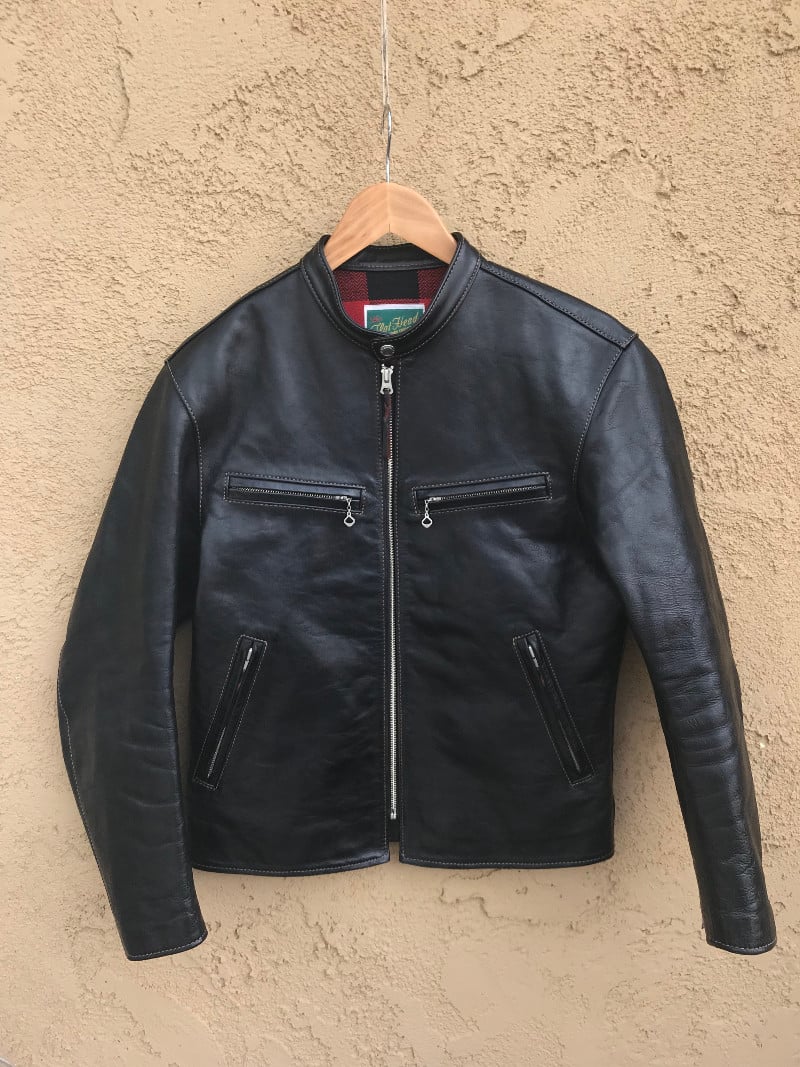
The Best: The Flat Head
Even if you’re not super into leather jackets, there’s a good chance you’ve heard of The Flat Head.
“They make basically everything,” says Jake. “They’ve made everything from boots, sneakers, wallets, women’s bags, and purses, they even make shirts and jeans. And, of course, leather jackets.”
Why Buy From The Flat Head
- Primo horsehide leather
- Fits wide shoulders, slim chest, narrow waist
The brand was founded by Masayoshi Kobayashi 1996. Kobayashi started off in the vintage clothing industry but eventually started making his own denim jeans. His passion for innovating existing designs blossomed and in a few short years, his brand was already a staple in the heritage market. Over the years, The Flat Head expanded from their mainline label to form other branches such as, The Flat Head Club, Real Blues Japan, and Hard Bird. Each label in The Flat Head family specializes in its own aesthetic and products.
Jake talked to the founder and former head of the company who said, “The Flat Head introduced The Real McCoy’s to Shinki Horsehide. So, The Flat Head was using Shinki before anyone else.”
That sentence may not make much sense to you but if you scroll down to the end of this article you’ll see a short glossary of leather. Basically, many consider Shinki horsehide leather the most primo jacket material on Earth.
“The Flat Head is very exclusive about the Shinki that it gets,” Jake adds. “It’s very very thick. The only thing people who don’t like Shinki complain about is that Shinki isn’t very thick.”
But that’s not the case here. Because The Flat Head get access to Shinki leather before international brands, they can secure the thicker stuff and make the best jacket from it. The Flat Head makes its jackets from vegetable tanned leather and you can expect the hide to be 1.3mm thick. This is the standard thickness for hard wearing motorcycle gear.
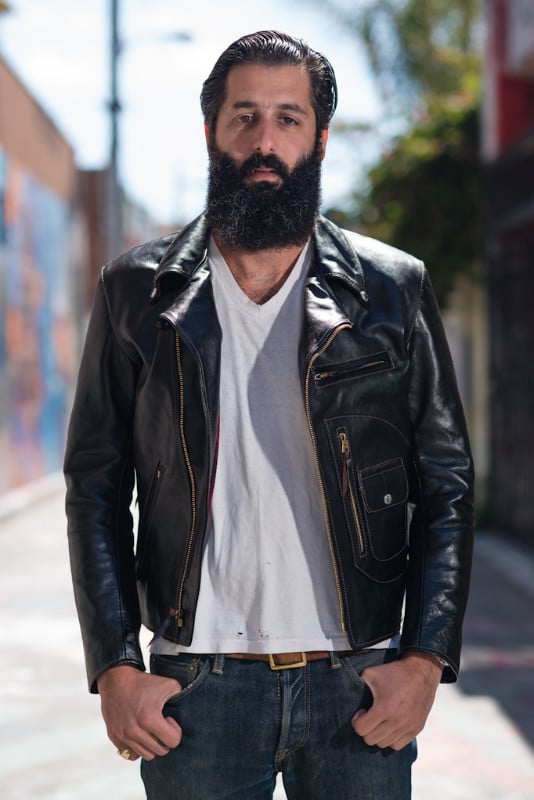
“It’s very flattering on you if it fits you,” says Jake. “It’s extreme: very wide shoulders, fairly slim chest, and very tapered into the waist. They’re a little bit long for me, I’m 5 foot 7.”
While it may sound great for athletic types, it might not work if you have a big chest.
“If you see people that fit into a Flat Head jacket nicely, they look perfect,” says Jake. “It’s very flattering if it fits well. That’s one thing you need to know about with leather jackets: there are some brands that won’t fit you very well. You just have to accept that.”
The Flat Head Price & Availability
- ~$2000
These jacket are not very easy to find, which is a common issue with a lot of Japanese brands. If you enjoy the hunt, but if you want something that is unique and worth your time to get, this is one is worth going and getting.
The Flat Head is available in a few places at stores and sometimes there’s stock online, but not always. In the UK you can often get them at Rivet and Hide, in the United States you can try Self Edge. They have shops in New York, San Francisco, LA, and Portland. You’ll want to check stock before making the trip, or you can just buy online from them.
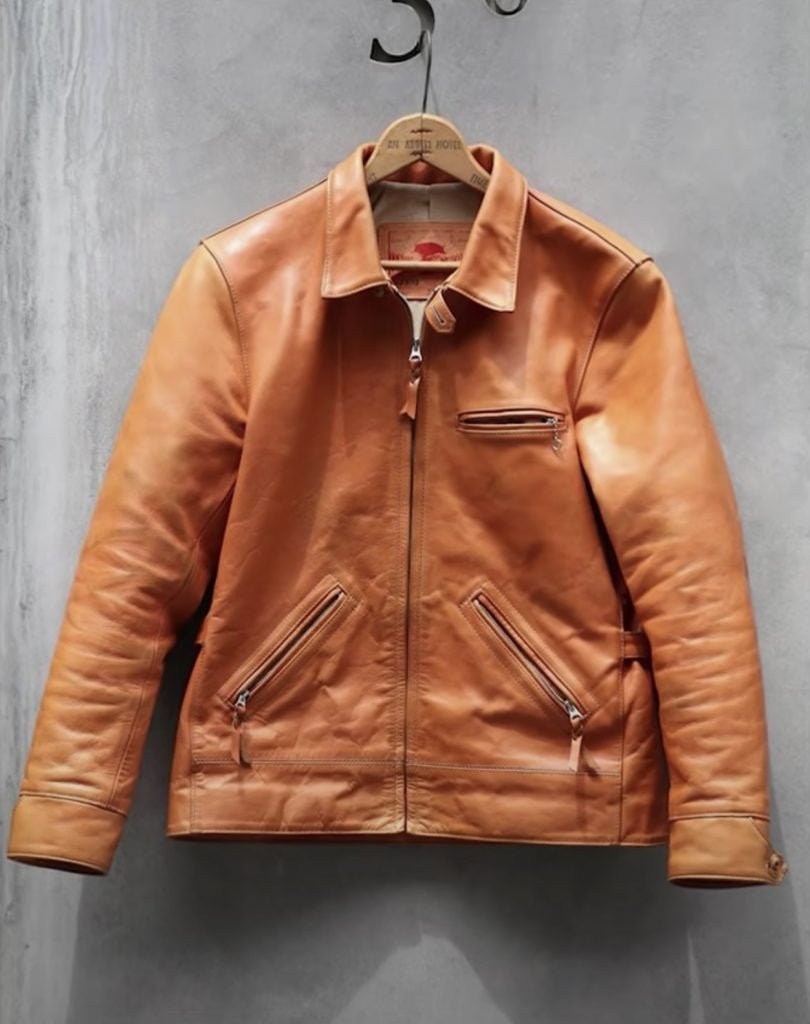
The Most Underrated: Tenjin Works Leather Jacket
This is a very underrated brand that’s not well known, but they’re based in Tokyo and make all of their jackets themselves.
Why Buy Tenjin Works
- Only vegetable tanned cowhide
- Famous for their natural jackets’ patina
They have a lot of colors available but one thing that they’re most famous for is their natural, vegetable tanned cowhide that they use.
“They make all their jackets out of vegetable-tanned cow leather,” says Jake. “The aging is crazy. If you see pictures of it, it gets really dark.”
You can see an example above — you might think that was purchased in orange, but it started as more of a neutral light gold.
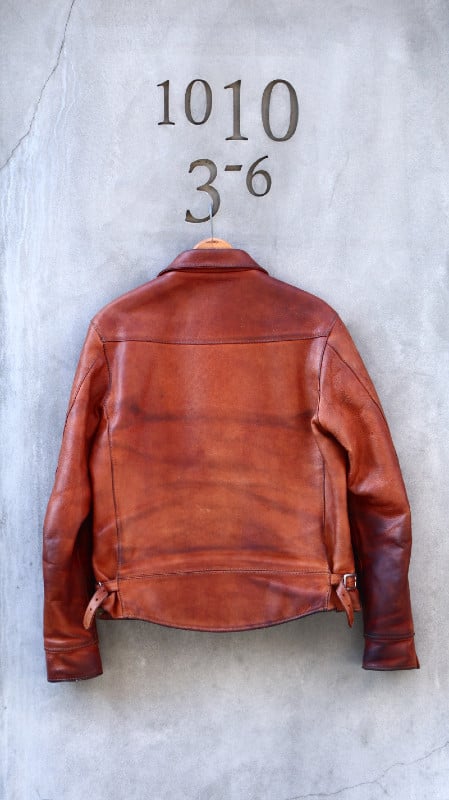
But Tenjin Works has a range of other colors that include burgundy, olive, dark brown, and even navy blue.
They achieve these cool colors and unique patina because they source their leather from Tochigi Leather Co, a tanner that only uses natural vegetable tanning processes to produce their leather. Tenjin Work’s leather of choice is Tochigi’s kip leather. Kip leather is leather made from the hide of a very young cow (usually between the age of 6 months to 2 years old). It’s lighter, yet has more tensile strength than American steerhide, making it a great option for easy break-in casual jackets.
Over at Tochigi, the tannery produces the leather in 160 pits and use tannins made from Brazilian Mimosa. During the tanning process, the hides are first dipped into areas with low tannin concentration, and over time, they are redipped into areas with more tannins until the process is complete.
Not only are their designs very well thought out and nicely varied (they even have a full leather peacoat!), but their stitch work is very neat and precise as well. These models below are JS01 and JS03 models.
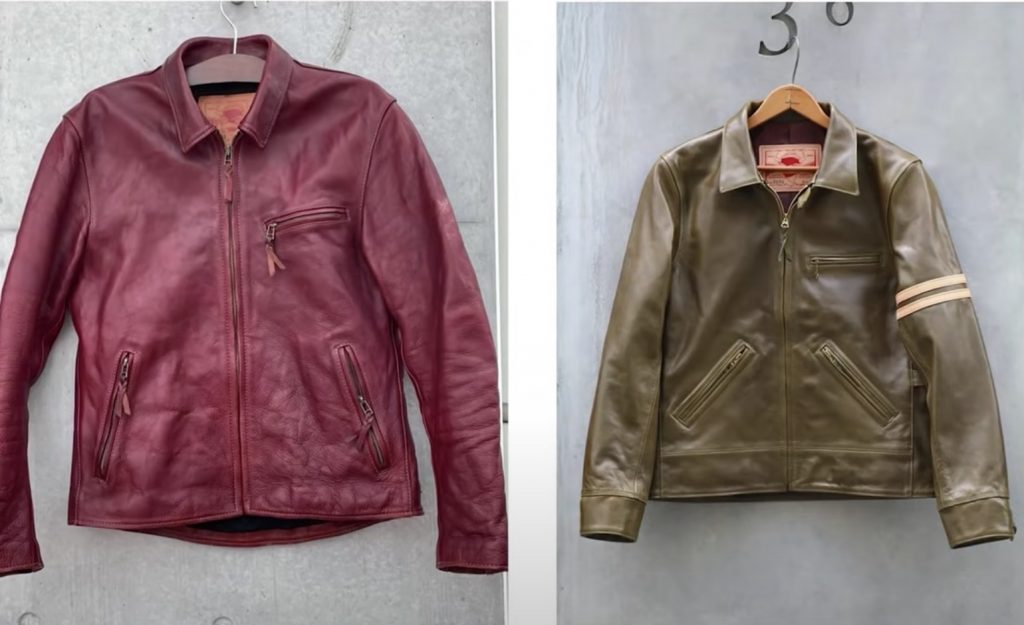
Tenjin Works Price & Availability
- ~$1,500+
The Tenjin Works jackets usually start around fifteen hundred dollars. With this level of design, quality, and leather, this is a relative bargain.
Some people have bought them overseas, but they are not something that’s super easy to find. Have a look at their website and try contacting them on Instagram to learn more about securing one.
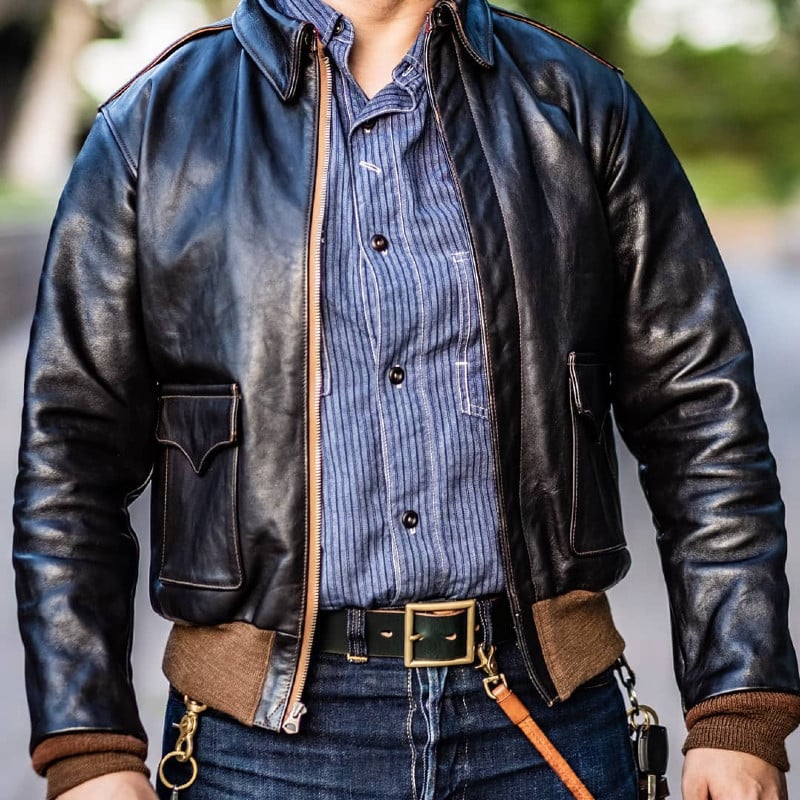
The Best Known: Real McCoy’s Leather Jackets
“Real McCoy’s is probably the brand that people think of first when they think of Japanese leather jackets,” says Jake. “They are known for making their jackets atelier style, so one person sews them from start to finish.”
They don’t do it on a production line: only one person sews all the sleeves, does all the buttonholing, everything. And they are made in Kobe, Japan.
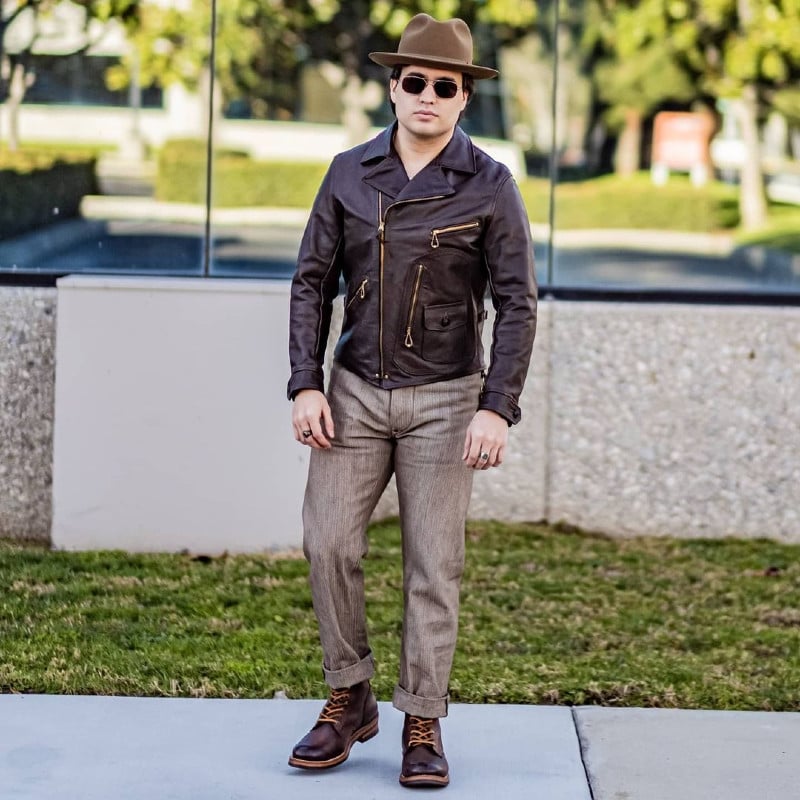
Why Buy Real McCoy’s
- Globally recognized for quality
- Short length, slim chest
“This fits me amazingly well especially for a stock jacket,” Jake says of his cross-zip. “Their fit isn’t super long, but probably fit people around 5 foot 10, 5 foot 11. They are slim around the chest, especially in their Buco motorcycle jackets, they will probably have a 40 or 41 inch chest. It’s pretty slim, it’s also pretty short.”
The allure for a lot of guys is the design: this is not a jacket you’re going to see everywhere. One of their best known is the cross-zip jacket you see above. Most guys that want a cross-zip wind up with something close to the Schott Perfecto motorcycle jacket, but cross-zips actually started as aviation jackets.
“An aviation-slash-motorcycle jacket had cross zips because they keep out the cold air when you’re in an airplane or on a motorbike,” says Jake. “But also in the 1930s and 1940s, they were well known as sports jackets, meaning a regular casual jacket. They call it the 30s Cooper Sports jacket.”
Aside from the cross-zip jacket jacket, The Real McCoy boast a diverse catalogue of other styles that will impress any vintage enthusiast. Some examples that stand out include their 30s sportswear inspired jacket, the Dillinger, their 40s inspired flight jacket, the modified Type D-1 and their 60s inspired moto jacket, the Enduro Trial. As you can see, it does not matter which era you’re into, The Real McCoy will have something made to the standards of that time period.
They are very high quality, using classic designs and luxury materials — expect a lot of vegetable tanned horsehide from Shinki Hikaku.
Price & Availability
- ~$1,800 – $2,600
You can actually buy these pretty easily off of their official website. If you’d rather try them on, there are quite a lot of retailers that sell them in the West like The Real McCoy’s store in London or Standard & Strange in the U.S. If it’s something they can get in stock, they can ship it over to you with no extra charge.
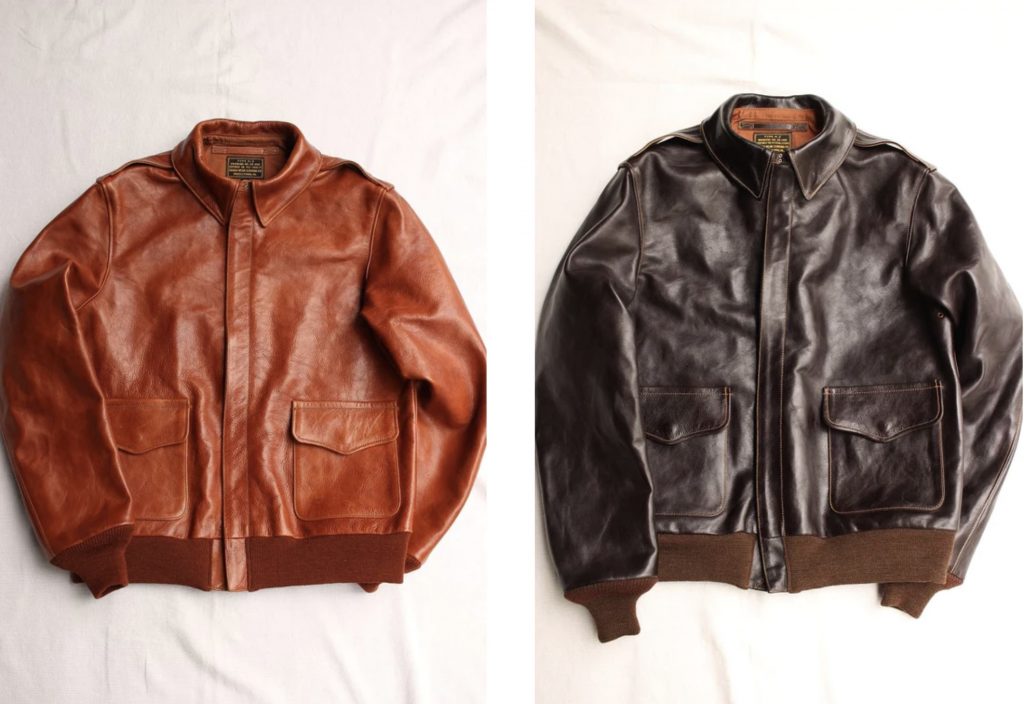
The Underdog: Rainbow Country Jackets
Rainbow Country is made in Kobe and despite being devilishly difficult to find, these have been named the second best Japanese brand. A bonus of their hard-to-find-ability is that they’re not as expensive as the final entry on this list, despite being made in the same factory.
Fit & Style
- Classic designs like A-2, cross-zips, and car coats
Devised as a house brand of the factory owner, Rainbow Country’s products are largely the same quality as better known alternatives like The Real McCoy’s and Freewheelers, but they cost a little less and have slightly less intricate stitching and liners. It’s basically a little more simplified version of the big hitters, which is more than enough for most enthusiasts.
Another thing interesting about this brand is that they’re not shy to show the world their manufacturing process, which is rare for a Japanese brand. On their FaceBook page — when it was active — Rainbow Country has proudly shared pictures of leather being processed, wool being cut, and hardware being added on to their jackets. It takes incredible confidence in ones own work to show off unfinished and imperfect versions of their product.
They also offer some products that Freewheelers doesn’t, like A-2 jackets, and certain colors that are less common with other brands, like the lovely shade of orange-brown above.
Rainbow Country has a decent selection of styles like half belts, car coats, and some cross-zip motorcycle-style jackets.
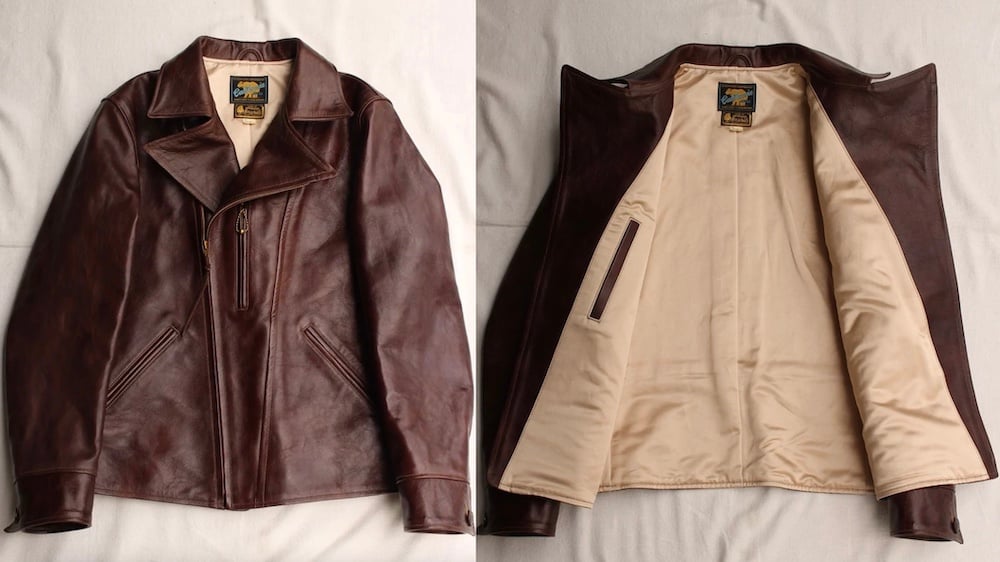
Price & Availability
- $1,400 – $2,000
These are very hard to get and nobody stocks them in the West. They don’t even have a website. You need to get in touch with a Japanese stockist that sells them: Mirror Ball and Mushmans do, but McFly‘s website is the easiest to navigate for non-Japanese speakers. You can also go to Japan to get them, where they’ll be a little cheaper.
Something like the Freewheeler’s jackets are around $2,500 to over $3,000 dollars, whereas a Rainbow Country jacket will run you probably around $1,400 to $2,000.
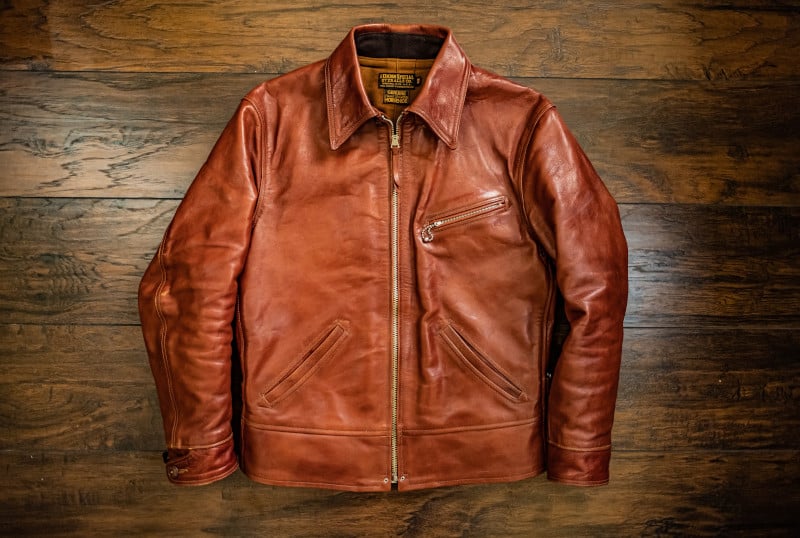
Best Overall: Freewheelers & Co.
Freewheelers is world renowned for their materials, attention to detail, quality, and patterns.
“They only do vintage jackets that they’re reproducing, maybe with some slight modifications,” says Jake. “It won’t always be exactly the same, but they are classic jackets. They’re not some new fashion or trend.”
But even though they emphasize recreations of old patterns, they still stand out in the market by reproducing rare jackets that other brands don’t. An example is their La Brea jacket, a D-style motorcycle jacket that other brands started reproducing — after Freewheelers did.
They simply put more attention to detail in every aspect of their production process; Jake can point to minor flaws in all of his other jackets. Not Freewheelers.
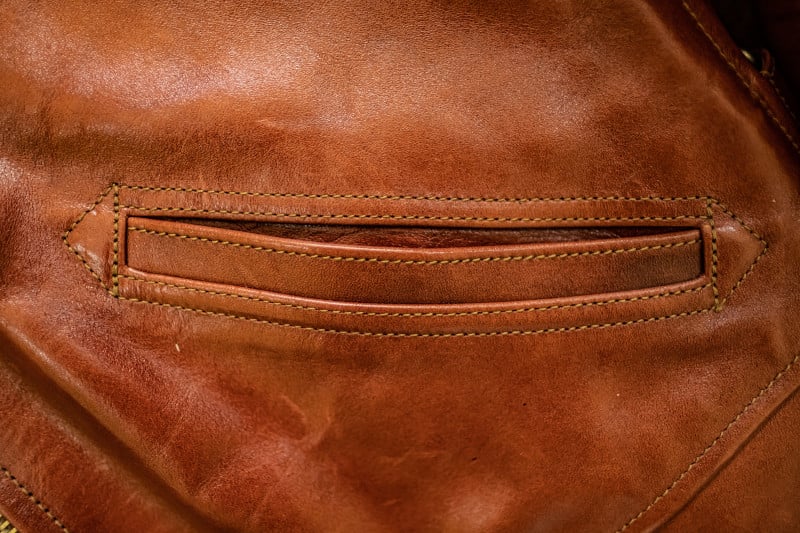
Leather & Materials
- Shinki horsehide
- Variety of cottons
“I think they put more attention into their materials than any other maker I’ve ever experienced. For example, this jacket has four different materials in it,” says Jake. “They have one for the back of your neck, one for the body lining — a really nice, very soft flannel. It’s almost like moleskin and gorgeous olive, almost mustard color. Then they have a different plaid brush flannel in the arms, which is just also very nice and another kind of flannel lining the pockets. That they have a variety of amazing materials is really unique.”
A lot of other brands will tell you that cotton canvas in the sleeves allows you to get your jacket off easily. That’s not true — having flannel in your jacket is really comfortable. This jacket is the most comfortable leather jacket I’ve ever owned.
Then, of course, the Shinki horsehide, which is unique to Freewheelers — they even finish it themselves, so no one else will have this exact kind of brown color.
The attention to detail in the stitching is also more precise than you see elsewhere. They also use a wide variety of different individually luxurious materials.
The patterns are very well done and if they fit, they will flatter you. The fit varies by models: a La Brea is V-shaped, a Mulholland is boxier, their Brakeman car jacket is more A-shaped. Speak to your stockist to decide what’s right for you.
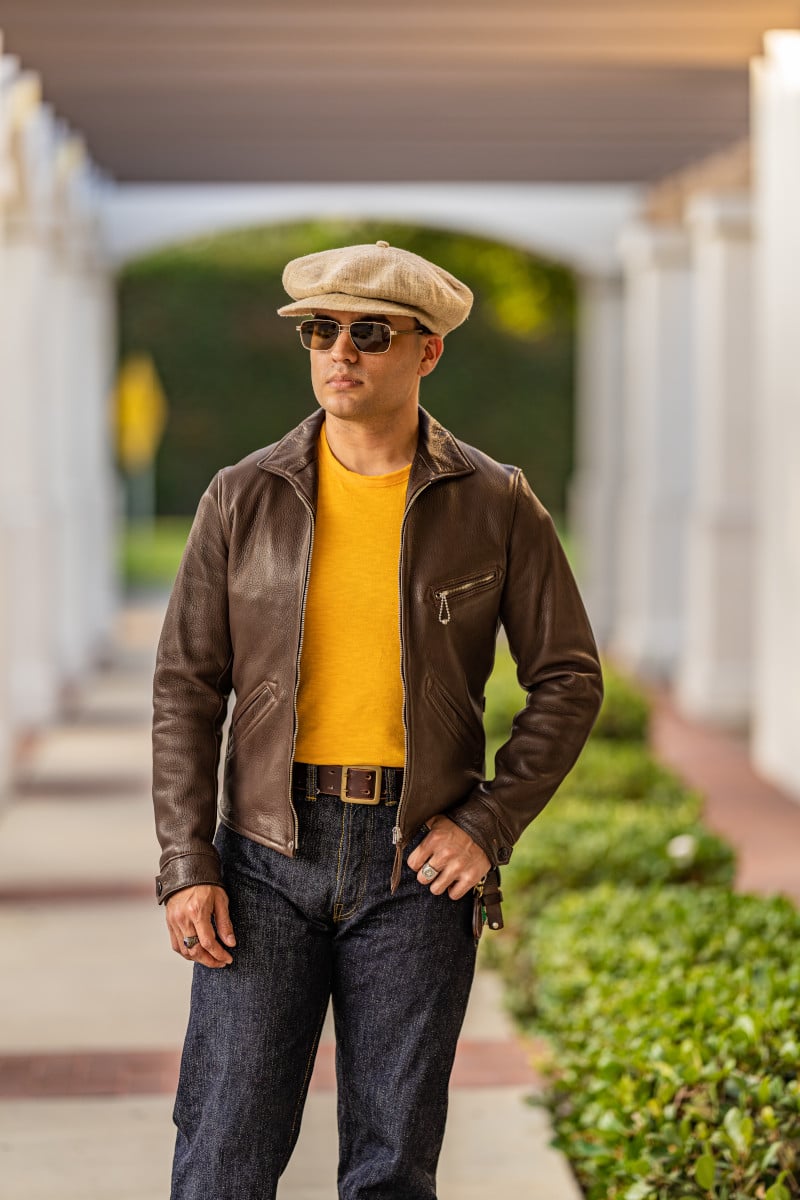
Price & Availability
- $1,800 – $2,500
What’s available to buy depends heavily on the season and what isn’t sold out. (Duh.) The only store they link from their website is Desolation Row in Japan, but you might find more options at McFly or Corlection.
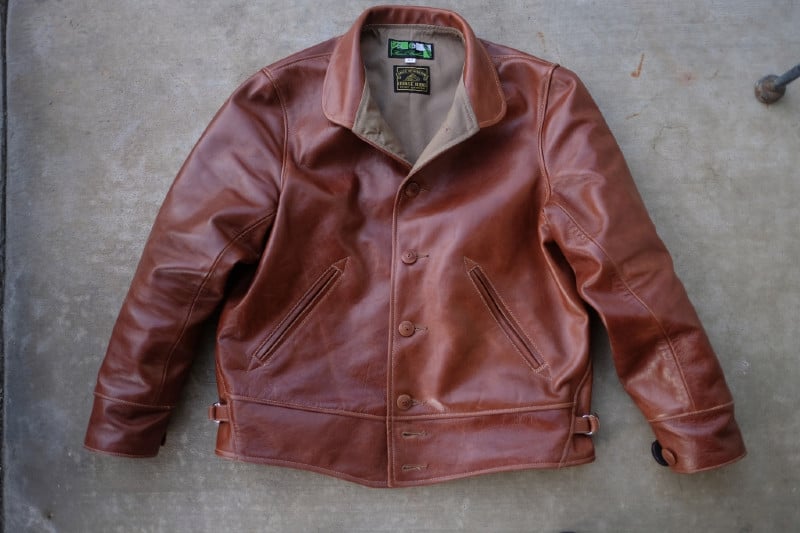
Background on Vintage Jackets
For those who aren’t familiar with the vintage leather jacket scene, there are a few ways that they tend to differ from the average 2020-something leather jacket and the best of them, arguably, are coming out of Japan. Amekaji is a kind of fashion that either recreates or is inspired by mid-20th century garments, a time when these items of clothing were chosen with intent, to be used in extreme situations that warrant a durable, sturdy jacket.
The primary purpose for these jackets was not style or comfort, and while a leather jacket makes you look cool, it may not be the coziest, softest thing in your wardrobe. These jackets stay true to their original purposes as sports jackets, aviation jackets, and motorcycle jackets. But as they break in and soften with dedicated wear, many find them to become the most comfortable outerwear they own.
Here are some typical features you’ll find on these kinds of jackets.
Japanese Jacket Leather
Japanese leather jackets often use horsehide and cowhide. The most sought-after are made of Shinki horsehide leather and vegetable tanned cowhide.
Horsehide is popular because it has a really tight grain structure that blocks wind and rain, it resists abrasion, and it ages well.
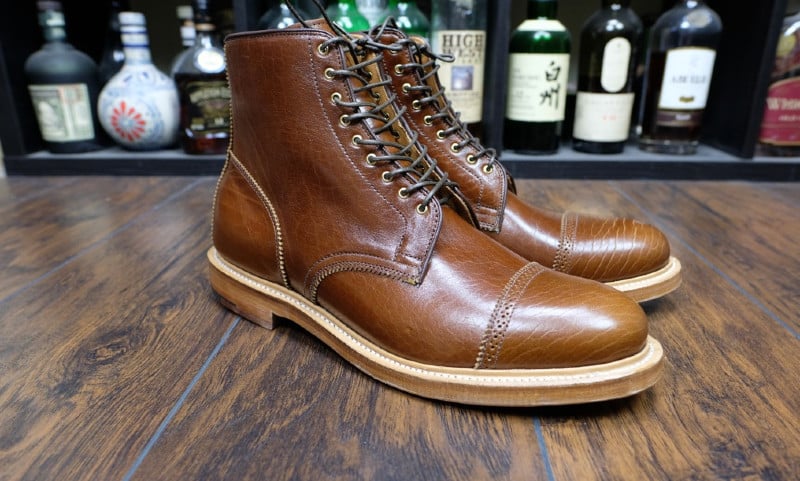
Boot Leather vs Jacket Leather
There are a lot of similarities between boot leather and jacket leather. If you’re a guy that enjoys learning about top-shelf leathers, a lot of the names and terms like Horween, Shinki, and veg-tanned leather will be familiar.
The biggest difference between boot leather and jacket leather is the thickness or weight. Vintage jackets were protective armor, in a sense: they blocked wind and rain but also protected against road rash and other dangers. You find a lot of horsehide used in Japanese jackets, and we’ll focus on the two most common leathers in high-end Japanese jackets: vegetable tanned cowhide and Shinki horsehide.
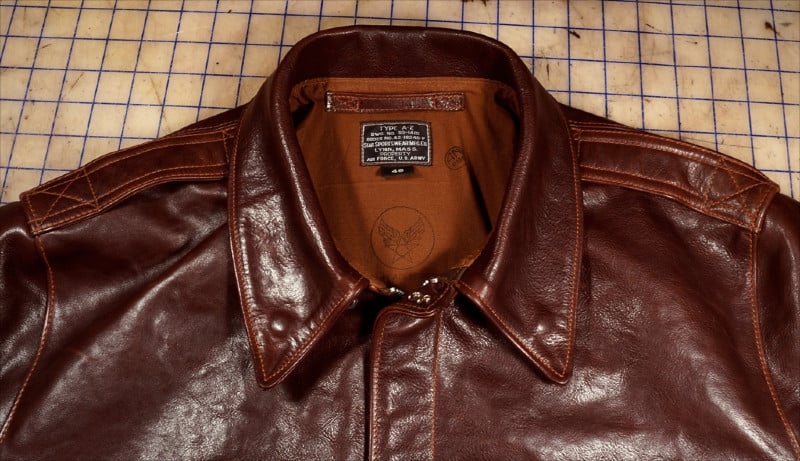
Why Vegetable Tanned Cow Leather?
I talk a lot about vegetable-tanned leathers. In short, there are two ways to tan leather — vegetable and chrome — and some 99 percent of leathers on Earth today are chrome tanned. This process was invented in the mid 19th century and while it has a lot of upsides, like elasticity and ease of dyeing, traditionalists prefer vegetable tanned leather for their jackets.
They are tanned slowly, using tannins found in bark and other vegetable matter. It tends to be more durable and to patina wonderfully. It even smells really nice. (See more of it in our review of this great leather satchel.)
So it makes perfect sense that if you’re investing in a really nice leather jacket, you’ll get a veg-tanned leather. Even though, yes, it’s more expensive than chrome.
Jackets using the Italian tannery Badalassi ’s veg-tanned leather are highly sought after.
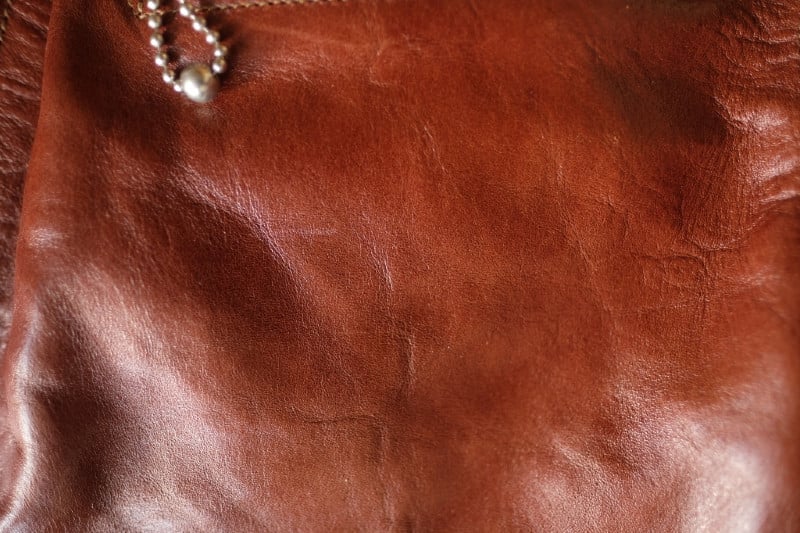
Why Shinki Horsehide?
Shinki Hikaku Horsehide leather comes from Kobe, Japan. Shinki has been in business since 1951 and is one of the few remaining tanneries producing this specific leather. They are well known for their attention to detail, beautiful hides, and rich colors. Shinki is luxurious, attractive, and ages beautifully. I’d say it’s similar to wine, but wine hits a peak and these jackets just get better with age.
Shinki leather ages differently than chrome tanned leather. Vintage jacket aficionados want well-defined tunneling, the pattern to the creasing that goes on the arms. You want to see the grain variation.
A fair few places outside of Japan sell Shinki now, but you will not get the same Shinki horsehide from Western makers as you will from Japanese makers, who get priority.
Brands like the Flathead, The Real McCoy’s, and Freewheelers get the first pick of the available Shinki, plus they’ll often produce jackets that are thicker than what you can get in the West.
Wrapping Up
If you’re first starting out in leather jackets and you just want a cool leather jacket, you probably won’t want to start with a rare Japanese jacket, but once you know what you really want, you should escalate to one of these brands.
I want to thank Jake for taking the time to explain these jackets. Be sure to follow him on Instagram and check out his website. I’ve been pulling lots of photos from his Instagram and website for the video I made and for this article.

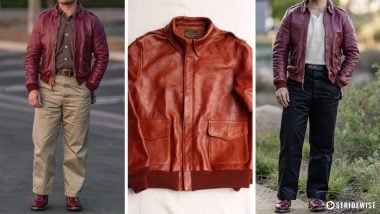

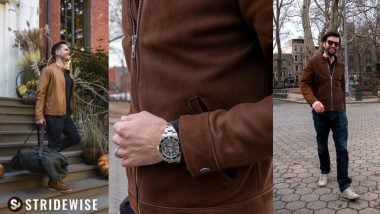

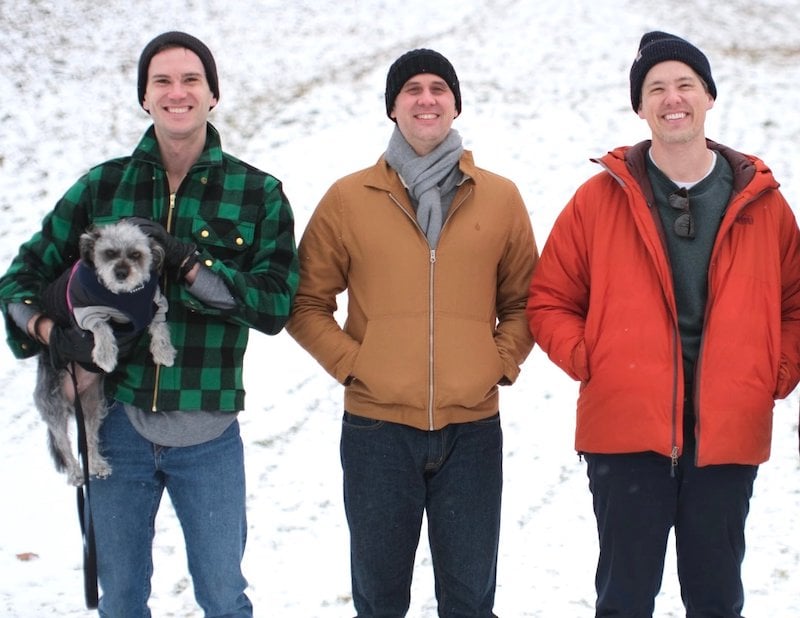


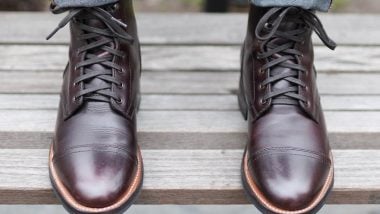
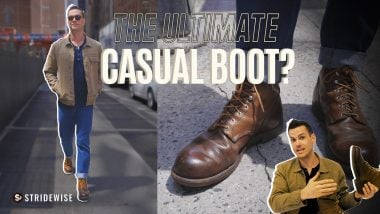
Join the Discussion